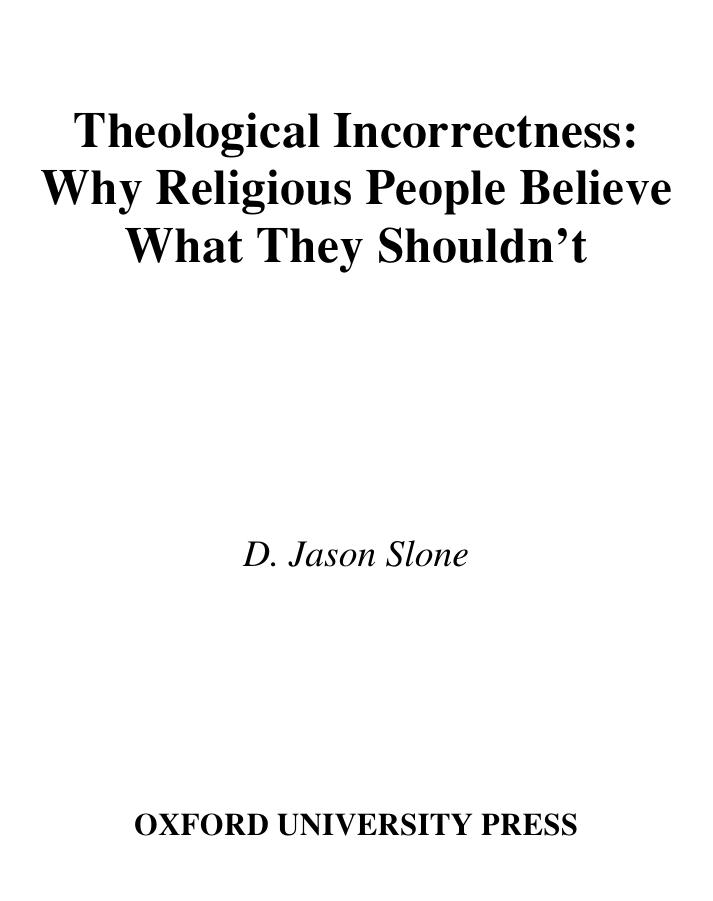Theological Incorrectness: Why Religious People Believe What They Shouldn't by D. Jason Slone

Author:D. Jason Slone [Slone, D. Jason]
Language: eng
Format: epub, pdf
ISBN: 9780195169263
Representing the Buddha
At the heart of the question about why Buddhists are “religious” if the Buddha taught nontheism is a more fundamental question about the nature of the Buddha. For example, how is it Buddhists simultaneously hold that the Buddha has achieved parinirvana and therefore has no existence and yet is still “present” to be worshiped? Fortunately, cognitive research suggests an answer. In fact, there are actually two answers to this question because the prob
end p.75
lem is actually based on two puzzles. The first puzzle is how can people represent dead persons as still being “alive” after death at all? The second puzzle is how can a person, dead or alive, be represented as being “present” in objects (e.g., relics) that are physically separate from his or her body?
An answer to the first question requires that we understand how human beings conceptualize death in general, because how human beings represent dead persons has much to do with the belief in the continuation of the Buddha despite his death and parinirvana (and all beliefs in an afterlife). The belief in the continuation of life after death is made possible by the cognitive capacity to represent objects as existing despite their apparent nonexistence (as indicated by their absence from our immediate perceptual field). One of the first psychologists to study this phenomenon scientifically was Jean Piaget, who called it the capacity for “object permanency” (Piaget 1926, 1954). Representing objects as existing permanently is so basic to our cognitive abilities that we often don't even notice that we do it, even though it is a quite remarkable feat. Consider this. You are sitting in the living room watching a movie with your spouse. In the middle of the movie, your spouse hits the pause button on the remote control and goes to the kitchen to make some popcorn. As she (or he) turns the corner of the doorway, she goes out of your sight. Yet you know that she still exists. She is, according to your mind, simply somewhere else. Furthermore, you know that popcorn, a popcorn popper, bowls, salt, and butter also exist, even though you have no direct perceptual evidence for this knowledge at your immediate disposal. So how do you know these things exist? Well, you don't, really. You presume that these things exist because you've “encoded” them, we'll say, in your memory. You “represent” these objects as existing, and once an object is represented as existing, you represent it as always existing somewhere in the world (e.g., in the kitchen cupboard). Thus, you can represent objects as existing because you have the capacity for “object permanency.”
The capacity for object permanency suggests that the belief in afterlife is natural. Though still instructive, Piaget's theories have been fine-tuned in the past few years. One of the most interesting neo-Piagetian discoveries is that our supposed object permanency is actually even more sophisticated than Piaget proposed. Our capacity for object permanency is actually domain specific (Hirschfeld & Gelman 1994). We can conceptualize some
Download
Theological Incorrectness: Why Religious People Believe What They Shouldn't by D. Jason Slone.pdf
This site does not store any files on its server. We only index and link to content provided by other sites. Please contact the content providers to delete copyright contents if any and email us, we'll remove relevant links or contents immediately.
The remains of the day by Kazuo Ishiguro(8892)
Tools of Titans by Timothy Ferriss(8304)
Giovanni's Room by James Baldwin(7253)
The Black Swan by Nassim Nicholas Taleb(7056)
Inner Engineering: A Yogi's Guide to Joy by Sadhguru(6752)
The Way of Zen by Alan W. Watts(6553)
Asking the Right Questions: A Guide to Critical Thinking by M. Neil Browne & Stuart M. Keeley(5708)
The Power of Now: A Guide to Spiritual Enlightenment by Eckhart Tolle(5680)
The Six Wives Of Henry VIII (WOMEN IN HISTORY) by Fraser Antonia(5456)
Astrophysics for People in a Hurry by Neil DeGrasse Tyson(5151)
Housekeeping by Marilynne Robinson(4392)
12 Rules for Life by Jordan B. Peterson(4276)
Double Down (Diary of a Wimpy Kid Book 11) by Jeff Kinney(4241)
The Ethical Slut by Janet W. Hardy(4214)
Skin in the Game by Nassim Nicholas Taleb(4203)
Ikigai by Héctor García & Francesc Miralles(4173)
The Art of Happiness by The Dalai Lama(4092)
Skin in the Game: Hidden Asymmetries in Daily Life by Nassim Nicholas Taleb(3961)
Walking by Henry David Thoreau(3923)
